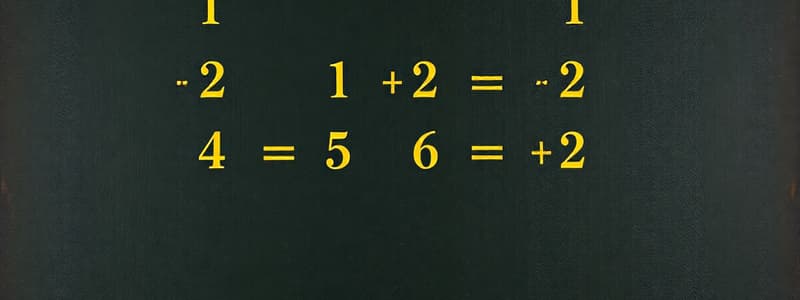Podcast
Questions and Answers
What is the result of the expression $3 + 5 \times (2 - 1)$?
What is the result of the expression $3 + 5 \times (2 - 1)$?
- 6
- 10 (correct)
- 8
- 11
Which of the following is a rational number?
Which of the following is a rational number?
- √3
- e
- π
- -4/7 (correct)
How do you simplify the fraction $\frac{12}{16}$?
How do you simplify the fraction $\frac{12}{16}$?
- $\frac{4}{3}$
- $\frac{2}{3}$
- $\frac{12}{8}$
- $\frac{3}{4}$ (correct)
What is the cube root of 27?
What is the cube root of 27?
If you have the fraction $\frac{2}{5}$ and you want to convert it into a percentage, what is the result?
If you have the fraction $\frac{2}{5}$ and you want to convert it into a percentage, what is the result?
What is the primary difference between area and perimeter?
What is the primary difference between area and perimeter?
Which of the following statements correctly describes the mean of a set of numbers?
Which of the following statements correctly describes the mean of a set of numbers?
What defines a variable in algebra?
What defines a variable in algebra?
How would you determine the range of a data set?
How would you determine the range of a data set?
Which of the following units is commonly used to measure volume?
Which of the following units is commonly used to measure volume?
Flashcards
Addition
Addition
Adding two or more numbers to find their total.
Subtraction
Subtraction
Finding the difference between two numbers.
Exponents
Exponents
A number multiplied by itself a specified number of times.
Numerator
Numerator
Signup and view all the flashcards
Denominator
Denominator
Signup and view all the flashcards
Perimeter
Perimeter
Signup and view all the flashcards
Area
Area
Signup and view all the flashcards
Volume
Volume
Signup and view all the flashcards
Variable
Variable
Signup and view all the flashcards
Equation
Equation
Signup and view all the flashcards
Study Notes
Basic Arithmetic Operations
- Addition: Combining two or more numbers to find their sum. Example: 2 + 3 = 5
- Subtraction: Finding the difference between two numbers. Example: 5 - 2 = 3
- Multiplication: Repeated addition of a number. Example: 2 x 3 = 6 (2 added 3 times)
- Division: Splitting a number into equal parts. Example: 6 ÷ 2 = 3 (6 split into 2 equal groups)
Order of Operations (PEMDAS/BODMAS)
- Parentheses/Brackets: Operations inside parentheses are performed first.
- Exponents/Orders: Calculations with exponents are done next.
- Multiplication and Division (from left to right): Performed from left to right in the expression.
- Addition and Subtraction (from left to right): Performed from left to right in the expression.
Number Systems
- Natural Numbers: Counting numbers (1, 2, 3,...).
- Whole Numbers: Natural numbers plus zero (0, 1, 2, 3,...).
- Integers: Whole numbers and their opposites (-3, -2, -1, 0, 1, 2, 3,...).
- Rational Numbers: Numbers that can be expressed as a fraction p/q, where p and q are integers, and q is not zero. Examples: 1/2, 3/4, -2/5.
- Irrational Numbers: Numbers that cannot be expressed as a fraction of two integers. Examples: π (pi), √2.
- Real Numbers: The set of all rational and irrational numbers.
Fractions
- Numerator: The top number of a fraction, representing the parts.
- Denominator: The bottom number of a fraction, representing the whole.
- Equivalent Fractions: Fractions that represent the same value.
- Simplifying Fractions: Reducing a fraction to its lowest terms.
- Adding/Subtracting Fractions: Need a common denominator.
- Multiplying Fractions: Multiply the numerators and denominators.
- Dividing Fractions: Multiply by the reciprocal of the divisor.
Decimals
- Place Value: Understanding the value of digits based on their position.
- Converting Between Fractions and Decimals.
Percentages
- Representing a part of a whole as a fraction of 100.
- Calculating percentages.
- Converting between fractions, decimals, and percentages.
Exponents and Radicals
- Exponents: Repeated multiplication of a number. Example: 23 = 2 x 2 x 2 = 8
- Roots: Finding a number that, when multiplied by itself a certain number of times, equals a given number. Example: √9 = 3
- Square Roots: Finding the number that when multiplied by itself equals a given number.
- Cube Roots: Finding the number that when multiplied by itself three times equals a given number.
Geometry
- Basic Shapes: Understanding two-dimensional shapes like squares, rectangles, triangles, circles, and three-dimensional shapes like cubes, spheres, and cones.
- Perimeter: The distance around the outside of a two-dimensional shape.
- Area: The space inside a two-dimensional shape.
- Volume: The space occupied by a three-dimensional object.
Algebra
- Variables: Symbols used to represent unknown values. Examples: x, y, z
- Equations: Statements of equality between two expressions. Examples: x + 2 = 5.
- Solving Equations: Finding the value of the variable that makes the equation true.
Data Analysis and Statistics
- Mean: Average of a set of numbers.
- Median: Middle value in a sorted set of numbers.
- Mode: Most frequent value in a set of numbers.
- Range: Difference between the largest and smallest values in a set.
Problem Solving
- Developing a strategy to approach a mathematical problem.
- Using different approaches to solve problems; logical deduction, guess and check, working backwards.
Measurement Units
- Length (meters, centimeters, inches, feet)
- Weight/Mass (grams, kilograms, pounds)
- Volume (liters, cubic centimeters)
- Time (seconds, minutes, hours)
- Temperature (degrees Celsius, degrees Fahrenheit)
Studying That Suits You
Use AI to generate personalized quizzes and flashcards to suit your learning preferences.




